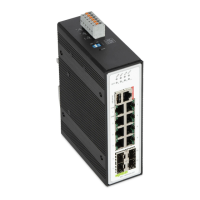50 Enhanced Features WAGO-ETHERNET-Zubehör 852
852-1305 8/4-Port 100BASE-T/1000BASE-SX/LX
Manual
1.1.0
7.2 Advanced Settings
7.2.1 Bandwidth Limitation
7.2.1.1 QoS
Each egress port supports up to eight “Transmit Queues”. Each “Transmit Queue”
contains a list specifying the packet transmission order. Each incoming frame is
forwarded to one of the eight “Transmit Queues” of the assigned egress port based
on its priority. The egress port transmits packets from each of the eight “Transmit
Queues” according to a configurable sequence algorithm, which can be a
combination of SP (“Strict Priority”) and/or WRR (“Weighted Round Robin”).
Normally, networks operate on a best-effort delivery basis, i.e., all data traffic has
equal priority and an equal chance of being transmitted in a timely manner.
If congestion occurs, all data traffic has an equal chance of being dropped.
When configuring the QoS (“Quality of Service”) function, you can select a
specific data traffic, prioritize it according to its relative importance and use
congestion management and congestion-avoidance techniques to give preferential
treatment.
Implementing QoS in a network improves network predictability and increases
bandwidth utilization.
The industrial managed switch supports “802.1p Priority Queuing”.
The switch has eight “Priority Queues”. These priority queues are numbered,
where Class 7 is the highest and Class 0 the lowest priority queue. The eight
priority classes specified in IEEE 802.1p (p0 to p7) are mapped to the switches
priority queues as follows:
The “Priority Scheduling” is implemented in “Priority Queues”. The switch
operates the four “Hardware Priority Queues” sequentially, where it starts with the
highest “Priority Queue” (3) and ends with the lowest (0). Each “Hardware
Queue” transmits all packets in its buffer before the next lower priority is allowed
to transmit its packets. If the lowest “Hardware Priority Queue” transmits all its
packets, the highest starts to transmit its packets again that it received in the
meantime.

